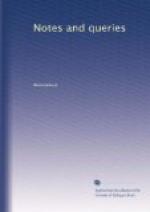EDWARD F. RIMBAULT.
Queen Elizabeth’s Translation of Boethius (Vol. ii., p. 56.).—One of JARLTZBERG’S inquiries is, “Has Queen Elizabeth’s work (which she executed during her captivity before she ascended the throne) been printed?” Certainly not: if it had been, it would have been well known. May we venture to anticipate an affirmative reply to another parallel question—Does Queen Elizabeth’s translation of Boethius exist in manuscript? But where did JARLTZBERG learn that it was “executed during her captivity before she ascended the throne?” We know that she made such a translation when she was sixty years of age, that is, in October and November, 1593, (see Nichols’s Progresses, &c., of Queen Elizabeth, vol. iii. p. 564., and the Gentleman’s Magazine for February last, p. 143.), and it is a very interesting proof of the continuance of her learned studies at that advanced period of her life; and, as the curious document which records this fact is unnoticed in the last edition of Royal and Noble Authors by Mr. Park, it is probably a misapprehension that the same task had engaged some of the hours of her captivity; or rather is it not one of those dove-tailing conjectures in which some of our most popular lady-biographers have recently exhibited such extravagant and misplaced ingenuity?
JOHN GOUGH NICHOLS.
Boethius’ Consolations of Philosophy (Vol. ii., p. 56.).—JARLTZBERG is wrong in supposing that Richard Viscount Preston’s translation appeared first in 1712. I have now before me an edition in 8vo. “London: printed by J.D. for Awnsham and John Churchill, at the Black Swan, in Paternoster row; and Francis Hildyard, bookseller in York, MDCXCV.” Horace Walpole, in his Royal and Noble Authors, states that the publication in 1712 was the “second edition corrected;” and Mr. Park says in a note, that the first edition was in 1695, 8vo.
C.H. COOPER
Cambridge, June 24. 1850.
* * * * *
ETYMOLOGICAL QUERIES ANSWERED.
J. MN. (Vol. ii., p. 153.) has propounded a dozen of most recondite and puzzling archaisms, upon which I have to offer a few notes.
“Rykelot, a magpie?”—The popular and provincial names of animals deserve more careful notice than they have received from glossarists. I need scarcely observe how frequently personal names were derived from those of birds. In the {170} Hundred Rolls we find a “Richard Rikelot” in Huntingdonshire (vol. ii. p. 626.). I know not what has led to the supposition that this name denotes the magpie. It may possibly be traced to the same root as that of a cognate species, the cornix frugivora; Roeck, Germ., according to Gesner; Friesic, roek; Ang.-S. hroc, the rook: but I am at a loss to discover anything similar in old French to explain the occurrence of the termination, which seems to be a popular or familiar diminutive, a Gallicism, analogous to partlot.




